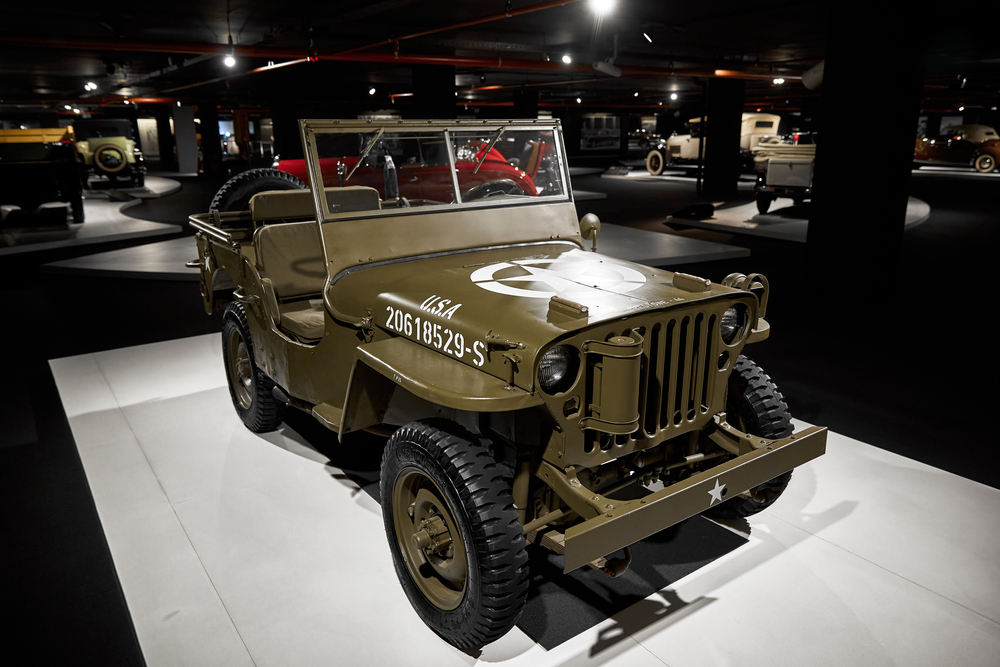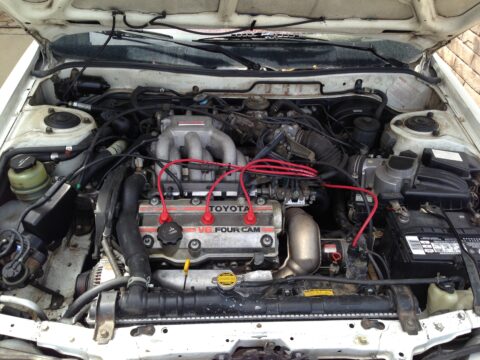Over the years, military vehicles have not only changed the face of warfare but have also set new standards for innovation, durability, and adaptability. From tanks that dominated battlefields to versatile transport vehicles, each one left a lasting impact on defense strategies worldwide. This list highlights 17 retired military vehicle models that played crucial roles in shaping military history and continue to influence today’s designs.
Contents
M4 Sherman Tank

The M4 Sherman tank became a WWII icon for its reliable mechanics and mobility across European and Pacific theaters. Known for its versatility, the Sherman could adapt to various battlefield needs, often modified with flame throwers, bridge layers, or amphibious kits. Despite being outgunned by German tanks, its sheer numbers and easy repairability made it essential. It represented the Allied focus on mass production and mechanized warfare, shaping future tank strategies globally.
Willys MB Jeep

The Willys MB, or Jeep, transformed battlefield transportation during WWII with its rugged design and unmatched versatility. Able to navigate rough terrain, the Jeep became a multipurpose vehicle, ideal for transporting soldiers, supplies, and even acting as a makeshift ambulance. Its impact on military mobility led to post-war adaptations, influencing civilian off-road vehicle design.
Panzer IV Tank

Germany’s Panzer IV was a WWII workhorse, deployed on both Eastern and Western fronts. Originally designed as an infantry support vehicle, it quickly evolved with thicker armor and a larger gun to counter enemy tanks. Its adaptability became a model for future tank design, showing the benefits of vehicles capable of both defense and offense. The Panzer IV’s innovations in armor and firepower set new standards for mechanized warfare.
T-34 Tank

The Soviet T-34 tank revolutionized armor technology with its sloped armor and powerful diesel engine. Known for its resilience and firepower, the T-34 proved essential in repelling German forces in WWII. Its design emphasized both speed and protection, inspiring future generations of tanks. The T-34’s success shifted global tank development toward more versatile, heavily armored models, impacting defense tactics worldwide.
M60 Patton Tank

The M60 Patton, a Cold War-era tank, provided the U.S. military with increased firepower and armor protection. Equipped with a powerful 105mm gun, it served as the main battle tank for NATO allies, especially in Europe. Its adaptability and upgrade potential allowed it to remain in service for decades. The M60’s development highlighted the importance of long-term versatility in military hardware, shaping NATO’s tank doctrine.
M113 Armored Personnel Carrier

The M113 APC redefined troop transport with its lightweight, amphibious capabilities, providing vital support in Vietnam and beyond. As one of the first fully tracked APCs, it could carry up to 11 soldiers in varied environments, from jungles to deserts. Its influence extended to modern infantry tactics, where rapid, protected troop movement became critical. The M113’s success demonstrated the need for adaptable, multipurpose personnel carriers in modern armies.
UH-1 Huey Helicopter

The UH-1 “Huey” helicopter symbolized U.S. military air mobility during the Vietnam War, providing rapid troop transport, medical evacuation, and close air support. Its ability to operate in dense jungles and remote locations made it invaluable for the guerrilla warfare tactics of the time. The Huey’s versatility transformed military doctrine, proving the effectiveness of helicopters in combat. This led to the expanded use of helicopters in modern military strategies.
M109 Howitzer

The M109 self-propelled howitzer provided U.S. artillery units with mobility and power, enhancing indirect fire support capabilities. Its ability to relocate quickly while delivering heavy firepower allowed it to support ground troops effectively. Used from the Vietnam War through recent conflicts, the M109 showed how mobile artillery could integrate with ground forces. This model set the standard for modern artillery systems in terms of mobility and firepower.
Leopard 1 Tank

Developed by West Germany, the Leopard 1 marked a shift toward fast, mobile tank designs that prioritized firepower and maneuverability. Known for its accuracy and speed, it became a staple in NATO’s European defense. The Leopard 1 emphasized the need for high-speed armored units in Cold War-era military planning. It established a precedent for future NATO tank development, blending firepower with tactical flexibility.
M3 Half-Track

The M3 Half-Track served the U.S. military in WWII as a versatile, armored transport for infantry and support roles. Blending the mobility of a truck with the protection of an armored vehicle, it was highly effective in varied terrain. This combination influenced future armored personnel carriers, shaping the design of hybrid vehicles in military operations. The M3’s unique configuration inspired similar designs in subsequent conflicts.
Challenger 1 Tank

The British Challenger 1 tank played a crucial role in the Gulf War, known for its advanced armor and 120mm rifled gun. It provided exceptional protection and offensive power, setting new standards for tank design. The Challenger 1’s use of Chobham armor technology demonstrated how advancements in defensive materials could improve battlefield survivability. This led to future tank models that emphasized crew safety alongside firepower.
HMMWV (Humvee)

Introduced in the 1980s, the HMMWV, or Humvee, provided U.S. forces with unparalleled off-road capability and versatility. Known for its durability, it became a multipurpose vehicle, adaptable to combat, logistics, and medical roles. The Humvee’s success reinforced the importance of flexible, light military vehicles for modern warfare. Its wide deployment spurred the development of similar tactical vehicles worldwide.
Stryker Armored Vehicle

The Stryker revolutionized infantry mobility in the early 2000s with its eight-wheeled, modular design. Capable of carrying various weapon systems, the Stryker supported U.S. infantry in Iraq and Afghanistan. Its adaptability allowed it to be outfitted with different configurations, reinforcing the need for modularity in military vehicles. The Stryker influenced the design of modern armored vehicles that emphasize flexibility and rapid deployment.
PT-76 Amphibious Tank

The Soviet PT-76 amphibious tank, first introduced in the 1950s, became known for its river-crossing capabilities, a critical advantage in the Cold War era. Its light armor and amphibious mobility made it suitable for reconnaissance and rapid assaults across water obstacles. The PT-76’s role emphasized the tactical advantages of amphibious tanks in military operations. This influenced later designs for light, water-capable vehicles.
Centurion Tank

The British Centurion tank, one of the most successful post-WWII designs, served in multiple conflicts for several decades. It combined strong armor, powerful weaponry, and excellent mobility, making it adaptable to diverse battle conditions. The Centurion’s design influenced many subsequent tanks, blending durability with firepower. It showcased how multi-role tanks could achieve longevity through constant upgrades.
FV101 Scorpion

The British FV101 Scorpion, a light reconnaissance tank, was designed for speed and mobility with its aluminum armor and 76mm gun. It proved effective in recon and support roles, especially in urban environments. The Scorpion demonstrated the advantages of lightweight, agile tanks for specialized missions. Its success highlighted the need for versatile vehicles capable of quick, tactical deployment in various terrains.
M551 Sheridan

The M551 Sheridan light tank, used by the U.S. in Vietnam and the Gulf War, featured a unique missile-firing gun for flexible combat. Its lightweight frame made it air-transportable, ideal for rapid deployment and airborne operations. Although challenging to operate, the Sheridan’s innovative design paved the way for lighter, missile-capable armored vehicles. Its development underscored the importance of adaptable, quick-deploy tanks in evolving combat environments.
This article originally appeared in MyCarMakesNoise.
More from MyCarMakesNoise
15 Behind-the-Scenes Secrets of Cruise Ship Operations

Cruise ships are floating marvels of modern engineering, but there’s more to them than meets the eye. Behind the scenes, these vessels operate with precision and complexity that most passengers never see. Read More.
14 Affordable RVs for Wallet-Friendly Travel

Ready to hit the open road without breaking the bank? We’ve got you covered. In this list, we explore 14 affordable RVs perfect for budget-friendly road trips. Whether you’re a solo traveler, a couple, or a family, these economical options offer the freedom and adventure of RV travel without the hefty price tag. Read More.
20 Public Transit Systems Leading the World in Innovation

Public transportation is evolving rapidly, with cities worldwide embracing advanced technologies to make commuting faster, safer, and more efficient. From high-speed trains to autonomous buses, these innovations are transforming how we travel. Read More.














